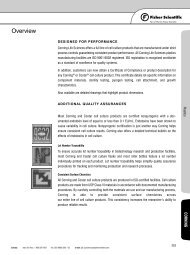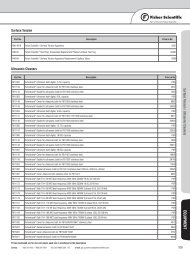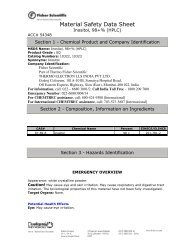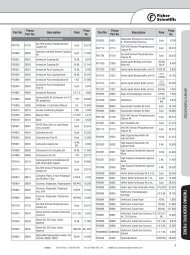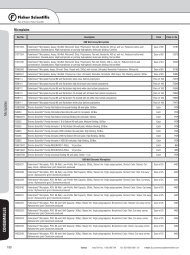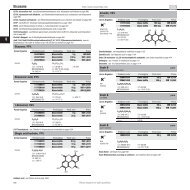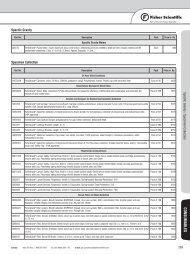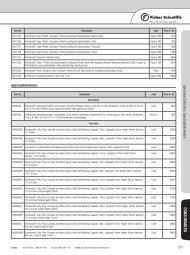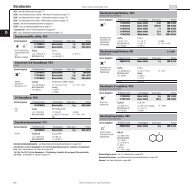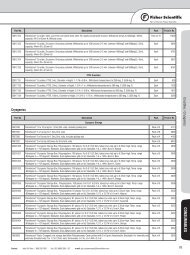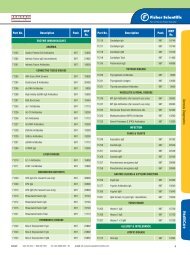Material Safety Data Sheet - Fisher Scientific: Lab Equipment
Material Safety Data Sheet - Fisher Scientific: Lab Equipment
Material Safety Data Sheet - Fisher Scientific: Lab Equipment
You also want an ePaper? Increase the reach of your titles
YUMPU automatically turns print PDFs into web optimized ePapers that Google loves.
<strong>Material</strong> <strong>Safety</strong> <strong>Data</strong> <strong>Sheet</strong><br />
trans-1,2-Diaminocyclohexane-N,N,N',N'-tetraacetic acid<br />
monohydrate, 98%<br />
ACC# 40434<br />
Section 1 - Chemical Product and Company Identification<br />
MSDS Name: trans-1,2-Diaminocyclohexane-N,N,N',N'-tetraacetic acid monohydrate,<br />
98%<br />
Product Grade : ExcelaR<br />
Catalog Numbers: 12623, 12624<br />
Synonyms: CDTA (trans-1, 2-Diaminocyclohexane-N,N,N’,N’-tetra Acetic Acid)<br />
Company Identification:<br />
<strong>Fisher</strong> <strong>Scientific</strong><br />
Part of Thermo <strong>Fisher</strong> <strong>Scientific</strong><br />
THERMO ELECTRON LLS INDIA PVT.LTD.<br />
Godrej Coliseum, 101A-101B, Somaiya Hospital Road,<br />
Off Eastern Express Highway, Sion (East), Mumbai-400 022, India<br />
For information, call: 022 – 6680 3001/2, Call India Toll Free – 1 800 209 7001<br />
Emergency Number: 022-66803004/14<br />
For CHEMTREC assistance, call: 800-424-9300 [International]<br />
For International CHEMTREC assistance, call: 703-527-3887 [International]<br />
Section 2 - Composition, Information on Ingredients<br />
CAS# Chemical Name Percent EINECS/ELINCS<br />
125572-95-4<br />
trans-1,2-Diaminocyclohexanetetraacetic<br />
acid monohydrate<br />
Section 3 - Hazards Identification<br />
EMERGENCY OVERVIEW<br />
98 unlisted<br />
Appearance: white crystalline powder.<br />
Caution! The toxicological properties of this material have not been fully investigated.<br />
Target Organs: No data found.
Potential Health Effects<br />
Eye: May cause eye irritation. No information regarding eye irritation and other potential<br />
effects was found.<br />
Skin: May cause skin irritation. May be absorbed through the skin in harmful amounts.<br />
No information regarding skin irritation and other potential effects was found.<br />
Ingestion: The toxicological properties of this substance have not been fully<br />
investigated. May be harmful if swallowed.<br />
Inhalation: The toxicological properties of this substance have not been fully<br />
investigated. May be harmful if inhaled.<br />
Chronic: No information found.<br />
Section 4 - First Aid Measures<br />
Eyes: Immediately flush eyes with plenty of water for at least 15 minutes, occasionally<br />
lifting the upper and lower eyelids. Get medical aid imme diately.<br />
Skin: Get medical aid immediately. Flush skin with plenty of water for at least 15<br />
minutes while removing contaminated clothing and shoes.<br />
Ingestion: If victim is conscious and alert, give 2-4 cupfuls of milk or water. Get<br />
medical aid immediately.<br />
Inhalation: Get medical aid immediately. Remove from exposure and move to fresh air<br />
immediately. If not breathing, give artificial respiration. If breathing is difficult, give<br />
oxygen.<br />
Notes to Physician: Treat symptomatically and supportively.<br />
Section 5 - Fire Fighting Measures<br />
General Information: As in any fire, wear a self-contained breathing apparatus in<br />
pressure-demand, MSHA/NIOSH (approved or equivalent), and full protective gear.<br />
During a fire, irritating and highly toxic gases may be generated by thermal<br />
decomposition or combustion.<br />
Extinguishing Media: In case of fire, use water, dry chemical, chemical foam, or<br />
alcohol-resistant foam.<br />
Flash Point: Not applicable.<br />
Autoignition Temperature: Not available.<br />
Explosion Limits, Lower:Not available.<br />
Upper: Not available.<br />
NFPA Rating: (estimated) Health: ; Flammability: 1; Instability:<br />
Section 6 - Accidental Release Measures
General Information: Use proper personal protective equipment as indicated in<br />
Section 8.<br />
Spills/Leaks: Clean up spills immediately, observing precautions in the Protective<br />
<strong>Equipment</strong> section. Sweep up, then place into a suitable container for disposal.<br />
Section 7 - Handling and Storage<br />
Handling: Wash thoroughly after handling. Remove contaminated clothing and wash<br />
before reuse. Avoid contact with eyes, skin, and clothing. Avoid ingestion and inhalation.<br />
Use with adequate ventilation.<br />
Storage: Store in a cool, dry place. Keep container closed when not in use.<br />
Section 8 - Exposure Controls, Personal Protection<br />
Engineering Controls: Use process enclosure, local exhaust ventilation, or other<br />
engineering controls to control airborne levels.<br />
Exposure Limits<br />
Chemical Name ACGIH NIOSH OSHA - Final PELs<br />
trans-1,2-<br />
Diaminocyclohexanetetraacetic none listed<br />
acid monohydrate<br />
none listed none listed<br />
OSHA Vacated PELs: trans-1,2-Diaminocyclohexanetetraacetic acid monohydrate: No<br />
OSHA Vacated PELs are listed for this chemical.<br />
Personal Protective <strong>Equipment</strong><br />
Eyes: Wear appropriate protective eyeglasses or chemical safety goggles as described<br />
by OSHA's eye and face protection regulations in 29 CFR 1910.133 or European<br />
Standard EN166.<br />
Skin: Wear appropriate protective gloves and clothing to prevent skin exposure.<br />
Clothing: Wear appropriate protective clothing to minimize contact with skin.<br />
Respirators: Follow the OSHA respirator regulations found in 29 CFR 1910.134 or<br />
European Standard EN 149. Use a NIOSH/MSHA or European Standard EN 149 approved<br />
respirator if exposure limits are exceeded or if irritation or other symptoms are<br />
experienced.<br />
Section 9 - Physical and Chemical Properties
Physical State: Crystalline powder<br />
Appearance: white<br />
Odor: None reported.<br />
pH: Not available.<br />
Vapor Pressure: Not available.<br />
Vapor Density: Not available.<br />
Evaporation Rate:Not available.<br />
Viscosity: Not available.<br />
Boiling Point: Not available.<br />
Freezing/Melting Point:> 210 deg C<br />
Decomposition Temperature:Not available.<br />
Solubility: slightly soluble<br />
Specific Gravity/Density:Not available.<br />
Molecular Formula:C14H22N2O8.H2O<br />
Molecular Weight:364.35<br />
Section 10 - Stability and Reactivity<br />
Chemical Stability: Stable under normal temperatures and pressures.<br />
Conditions to Avoid: Dust generation, excess heat.<br />
Incompatibilities with Other <strong>Material</strong>s: Oxidizing agents.<br />
Hazardous Decomposition Products: Nitrogen oxides, carbon monoxide, irritating<br />
and toxic fumes and gases, carbon dioxide.<br />
Hazardous Polymerization: Has not been reported.<br />
RTECS#:<br />
CAS# 125572-95-4 unlisted.<br />
LD50/LC50:<br />
Not available.<br />
Section 11 - Toxicological Information<br />
Carcinogenicity:<br />
CAS# 125572-95-4: Not listed by ACGIH, IARC, NTP, or CA Prop 65.<br />
Epidemiology: No data available.<br />
Teratogenicity: No data available.<br />
Reproductive Effects: No data available.<br />
Mutagenicity: No data available.
Neurotoxicity: No data available.<br />
Other Studies:<br />
No information available.<br />
Section 12 - Ecological Information<br />
Section 13 - Disposal Considerations<br />
Chemical waste generators must determine whether a discarded chemical is classified as<br />
a hazardous waste. US EPA guidelines for the classification determination are listed in 40<br />
CFR Parts 261.3. Additionally, waste generators must consult state and local hazardous<br />
waste regulations to ensure complete and accurate classification.<br />
RCRA P-Series: None listed.<br />
RCRA U-Series: None listed.<br />
Section 14 - Transport Information<br />
US DOT Canada TDG<br />
Shipping Name: Not regulated as a hazardous material No information available.<br />
Hazard Class:<br />
UN Number:<br />
Packing Group:<br />
US FEDERAL<br />
Section 15 - Regulatory Information<br />
TSCA<br />
CAS# 125572-95-4 is not listed on the TSCA inventory. It is for research and<br />
development use only.<br />
Health & <strong>Safety</strong> Reporting List<br />
None of the chemicals are on the Health & <strong>Safety</strong> Reporting List.<br />
Chemical Test Rules
None of the chemicals in this product are under a Chemical Test Rule.<br />
Section 12b<br />
None of the chemicals are listed under TSCA Section 12b.<br />
TSCA Significant New Use Rule<br />
None of the chemicals in this material have a SNUR under TSCA.<br />
CERCLA Hazardous Substances and corresponding RQs<br />
None of the chemicals in this material have an RQ.<br />
SARA Section 302 Extremely Hazardous Substances<br />
None of the chemicals in this product have a TPQ.<br />
Section 313 No chemicals are reportable under Section 313.<br />
Clean Air Act:<br />
This material does not contain any hazardous air pollutants.<br />
This material does not contain any Class 1 Ozone depletors.<br />
This material does not contain any Class 2 Ozone depletors.<br />
Clean Water Act:<br />
None of the chemicals in this product are listed as Hazardous Substances under the<br />
CWA.<br />
None of the chemicals in this product are listed as Priority Pollutants under the CWA.<br />
None of the chemicals in this product are listed as Toxic Pollutants under the CWA.<br />
OSHA:<br />
None of the chemicals in this product are considered highly hazardous by OSHA.<br />
STATE<br />
CAS# 125572-95-4 is not present on state lists from CA, PA, MN, MA, FL, or NJ.<br />
California Prop 65<br />
California No Significant Risk Level: None of the chemicals in this product are listed.<br />
European/International Regulations<br />
European <strong>Lab</strong>eling in Accordance with EC Directives<br />
Hazard Symbols:<br />
Not available.<br />
Risk Phrases:<br />
<strong>Safety</strong> Phrases:<br />
S 24/25 Avoid contact with skin and eyes.<br />
WGK (Water Danger/Protection)<br />
CAS# 125572-95-4: No information available.<br />
Canada - DSL/NDSL<br />
None of the chemicals in this product are listed on the DSL or NDSL list.<br />
Canada - WHMIS<br />
WHMIS: Not available.<br />
This product has been classified in accordance with the hazard criteria of the Controlled<br />
Products Regulations and the MSDS contains all of the information required by those<br />
regulations.<br />
Canadian Ingredient Disclosure List
MSDS Creation Date: 9/02/1997<br />
Revision #5 Date: 3/15/2007<br />
Section 16 - Additional Information<br />
The information above is believed to be accurate and represents the best information currently available to us.<br />
However, we make no warranty of merchantability or any other warranty, express or implied, with respect to such<br />
information, and we assume no liability resulting from its use. Users should make their own investigations to<br />
determine the suitability of the information for their particular purposes. In no event shall <strong>Fisher</strong> be liable for any<br />
claims, losses, or damages of any third party or for lost profits or any special, indirect, incidental, consequential or<br />
exemplary damages, howsoever arising, even if <strong>Fisher</strong> has been advised of the possibility of such damages.



